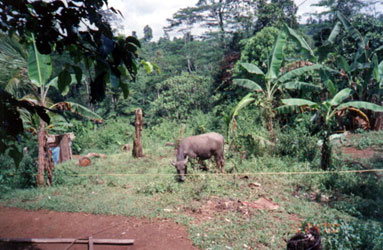N.B. - The article below was published in Forum (Vol. 4, No. 4, 28 April 2003, p. 5), official publication of the University of the Philippines (UP). The full text is also available at URL http://www.up.edu.ph/forum/2003/Apr03/dibabawon.html
The Dibabawon
of Barangay Buhi, Compostela Valley
Danilo Ara�a Arao
Assistant Professor, Department of Journalism
College of Mass Communication, UP Diliman
You know you are already in Barangay Buhi when you see on your right side a makeshift military detachment near an elementary school. There are no signs telling you that you are there. The only "welcome" you would get are curious glances from residents.
Unlike other upland communities, there is no need to walk countless kilometers of mountains, rivers and slopes. A motorcycle ride from the terminal of the Municipality of Laak in Compostela Valley will get you there.

This is a road with no name, just an indication that you are already in Barangay Buhi.
You need, however, to prepare yourself for a one-hour ride in a small, 150-cc motorcycle that is refurbished to accommodate five (yes, FIVE!) people including the driver. The latter assigns the "seating" arrangement, the smallest being made to sit on the tank. The tallest one (or the most experienced rider) is normally seated at the back end.
Since Buhi is an upland community, the motorcycle ride takes you to upland slopes and very rugged terrain. On rainy days, travel would have to be slow since the slopes can be very slippery and dangerous.
Both the commuters and driver do not wear any protective gear like helmets and kneepads, so a spill especially on rocky terrain could be dangerous to you and your group.
I had the misfortune of such an incident on the way back to Laak, and I was lucky to only sustain a bruised and sprained right leg. (The driver tried to force his way through an elevated hardened mud. However, his forward motion resulted in a sudden upward shift of the front wheel, sending all of us to the ground.)
Believe me, arriving in Barangay Buhi in one piece is the only blessing you can think of after that one-hour ride. Walking could be difficult if you do not shake off the leg cramps first.
After making a courtesy call to the military commander and the barangay captain, you are already free to tour the place and talk to the people living there.
This is a community composed mainly of the Dibabawon, one of the Lumad tribes in Mindanao concentrated in Compostela Valley. While they also have a unique language of the same name, the residents have learned to speak the Visayan language.

The Dibabawon people dress up like lowlanders, though their feet and hands
are calloused by the hardship of living in an upland area.
The Dibabawon recognize the moral authority of the Datu, a reference given to the village elder who is tasked to settle disputes given the wisdom acquired through the years. They also have Baylans or tribal priests or priestesses who perform rituals when someone, say, is sick or missing. There are also traditional songs and dances that are still known to the Dibabawon.
Aside from these, there is nothing substantially unique about the Dibabawon culture based on what you'll observe there. Just like a lowlander, the Dibabawon wear casual clothing that are normally tattered and old, an indication of poverty in the area.

A typical house in Barangay Buhi made of wood and nipa.
Their hands and feet are also calloused by the hard life in the mountains. Even children are not spared from such conditions, as they have developed the stamina to walk, carry heavy loads and perform other farm-related tasks under the scorching heat of the sun.
The Dibabawon there had learned to cultivate upland soil to plant traditional crops like palay, camote, gabi and corn. Each family also has chickens and/or pigs. Only a few families have carabaos and horses that are used to help in the farm and in transportation.

There are only a few Dibabawon families who own carabaos in Barangay Buhi.
They engage in agriculture and livestock mainly for domestic consumption. Even if they want to, they cannot possibly sell their agricultural products and livestock due to low quality and the lack of quick, viable transport to the town proper.
During trying times, a meal consists of corn rice (mais na bigas) and camote. There are even occasions when they have to make do with only camote or gabi, crops that are easier to plant and harvest. Families there are considered relatively well-off if rice is actually served with, say, sardines.
If they can manage to catch some, the Dibabawon also eat frogs cooked in boiling water. They are also experts in catching cobra which they also eat from time to time. They jokingly refer to these viands as "exotic" dishes.

A Dibabawon woman washes clothes near the hose.
This is where they also wash dishes and take a bath.
Water comes from a nearby river.
Given the lack of electricity, there is not much recreation after a day's work in the farm. The people normally sleep as early as 7 p.m. and wake up at around 4 a.m.
The Dibabawon get water for drinking and irrigation from the river which they also call Buhi. Through the help of the local government and non-government organizations, they acquired hoses that they use to get water for their farms and houses.

Unlimited supply of water from the river, courtesy of an indigenous technology.
It is ironic to observe poverty in an upland area where there is relative abundance of natural resources. Not so far from the area, there are forests which big logging companies wantonly exploit and the Dibabawon passionately defend. Mount Sangan, where Barangay Buhi is located, is also rich in marbles and other mineral resources.
The scenery that shows nature at its most pristine state does not accurately reflect the hardships of the people living there. It does imply, however, the reasons behind the intrusion of big logging companies in forested areas.
Surprisingly, the poverty in the area is a reason why the military had set up a detachment camp there.
In the eyes of the local government and the military, the economic deprivation of the Dibabawon is a breeding ground for the insurgency. In fact, some residents who were critical of persons in authority had been suspected as sympathizers of the New People's Army (NPA).
Barangay Buhi, in the end, is not a typical mountaineer's idea of an adventure, but an enlightening experience for those who may want to know more about poverty in a land of plenty.
Indeed, the Dibabawon's struggle for a better life continues in Barangay Buhi. The name of the place, after all, means just that --- Buhi = Buhay = LIFE.

The river that is also called "Buhi" which means life (buhay).
This is the source of water of the Dibabawon for drinking and irrigation.

